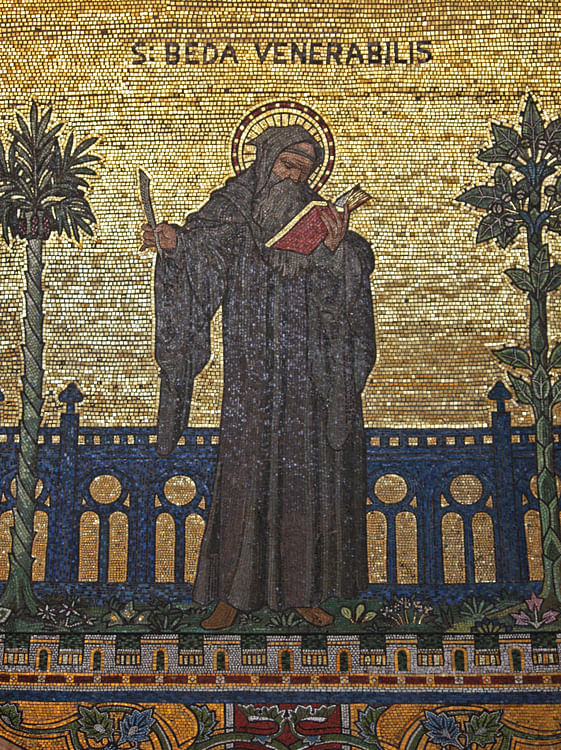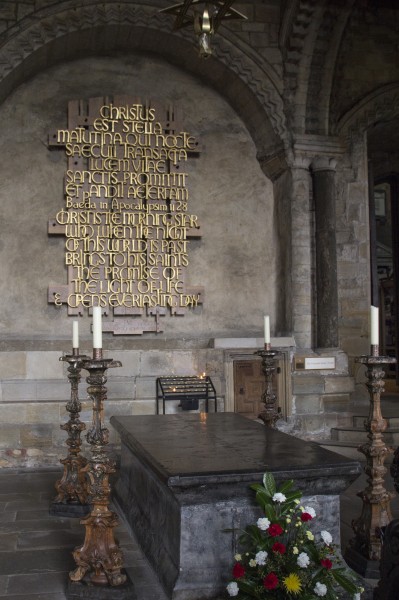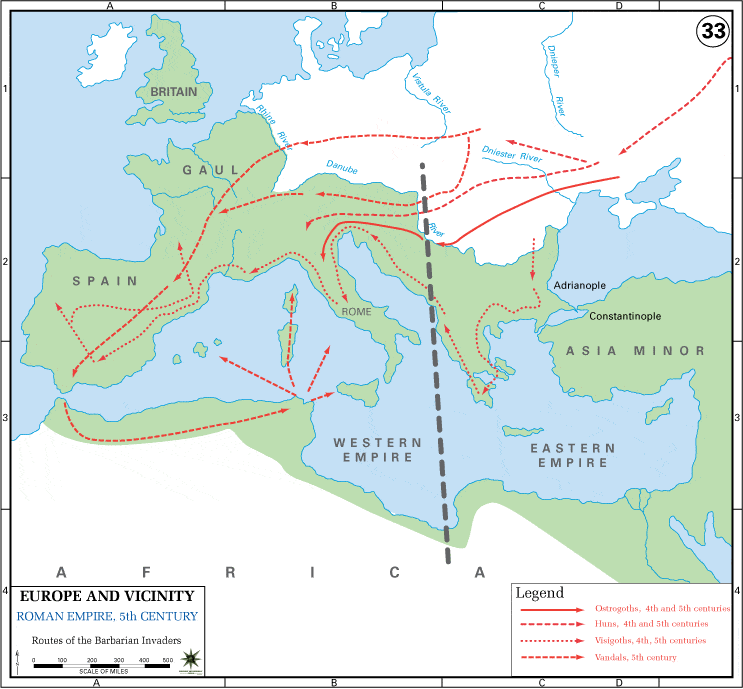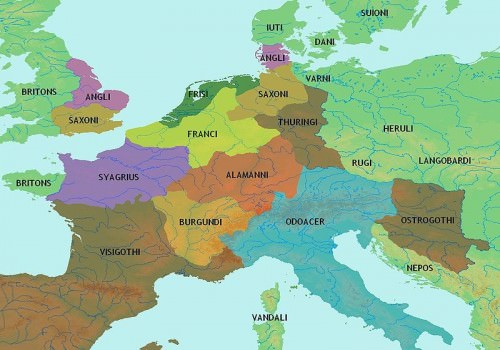Bede › Western Roman Empire » Ancient origins
Articles and Definitions › Contents
- Bede › Who Was
- Western Roman Empire › Antique Origins
Ancient civilizations › Historical and archaeological sites
Bede › Who Was
Definition and Origins

Bede (c. 673 CE - 735 CE) was an English monk, historian, and scholar who lived in the Kingdom of Northumbria. He is at times referred to as the Venerable Bede or Bede the Venerable. He was a monk at the double monastery of Monkwearmouth-Jarrow. Bede was a prolific writer and many of his works have survived to the present day. His work was extremely influential in the generations after his death. His most famous work, the Historia Ecclesiastica Gentis Anglorum ( Ecclesiastical History of the English People ), has been a vital source for the study of early English history for centuries. For this reason, he is remembered by some as the 'Father of English History.'
LIFE
Very little is known about Bede's life outside of what he himself writes in the final chapter of the Historia Ecclesiastica. Bede was born in either 672 or 673 CE; he claims to have been born on the very grounds of the monastery of Jarrow. This would mean he was born in Bernicia, the northernmost of the two Northumbrian kingdoms (Bernicia and Deira were already united into the Kingdom of Northumbria by the time of his birth), in what is now Sunderland. Bede says virtually nothing about his early life and very little external evidence exists. There seems to be some likelihood that he came from a noble family.Throughout his life, he had connections with the wealthy and powerful in Northumbria. In addition to this, some scholars have pointed to the name Beda (Old English for Bede) in a list of Kings of Lindsey (adjacent to Northumbria) as evidence that he was born to a wealthy or influential family.
Bede claims to have been sent to the monastery of Monkwearmouth on the River Wear to be educated by the abbot Benedict Biscop (c. 628 CE - 609 CE). Bede was raised at Monkwearmouth until about 682 CE, when he was transferred to the new abbey at Jarrow, founded by Saint Ceolfrith (c. 642 CE - 716 CE). Bede was made a deacon at the age of 19, several years prior to the canonical age of 25, which may be a sign of his exceptional abilities. He was fully ordained as a priest at the age of 30, and he seems to have written his earliest works around the turn of the 8th century CE for use in teaching in the monastery.His works cover the subjects of history, theology, and science, as well as a range of exegesis and hagiography. Bede is widely credited with helping to spread the use of the anno domini dating method, discussed in his work on chronology, De Temporum Ratione. Bede's adoption of the AD system, used at times in his Historia Ecclesiastica, popularized it for his contemporaries and subsequent generations.

Collected Works of Bede
Bede knew and communicated with many of the prominent clergymen and laymen of his day. As a young man he met Adomnan, then abbot of the important monastery of Iona. He was educated by Saints Benedict Biscop and Ceolfrith, who played crucial roles in the formation of the Church in northern England. He was ordained as a deacon and later as a full priest by Saint John of Beverley, who was the bishop of Hexham and of York at different points in his life and founded the town of Beverley in modern-day East Yorkshire. He regularly communicated with Saint Ecgbert of York, and correspondence between the two of them still survives today. Nothelm, an Archbishop of Canterbury, helped Bede find source material for the Historia Ecclesiastica. On a number of occasions, Bede encountered Wilfrid, the controversial Bishop of York. At one point, he wrote a letter to Wilfrid defending himself against an accusation of heresy. Bede was clearly known to the Northumbrian royalty as well, and he dedicated his greatest work to King Ceolwulf (reigned c. 729-737 CE) who consulted him regularly.
Bede died in May of 735 CE. According to one of his disciples who wrote an account of Bede's final days, he died singing a hymn. The account of Bede's death is quite detailed, describing Bede's illness, his last wishes, and his interactions with those around him. He apparently composed poetry on his deathbed as well. Following his death, he was buried at Jarrow. Though he was considered a saint soon after his death, he was not formally canonised until the end of the 19th century CE. However, he was also named a Doctor of the Church, the only native of Britain to hold this title.
HISTORIA ECCLESIASTICA GENTIS ANGLORUM
Bede's most well-known work is a history of the Christian Church in England. While Bede also provides an in-depth history of England up to his own lifetime, his main focus is the spread of Christianity in his native country. A lengthy discussion of the development of Anglo- Saxon kingdoms up to the 8th century CE is complemented with a catalogue of saints, converted kings, and miracles. Bede pays particular attention to the rivalry between Rome -centered Church practice and the CelticChristian communities which had been present in Britain and Ireland for centuries before the arrival of the Anglo- Saxons.Bede's work is considered one of the most important sources of Anglo-Saxon history for modern-day scholarship. It is a major source for political, social, and religious history in England during the early Anglo-Saxon age.
BEDE'S WORK IS CONSIDERED ONE OF THE MOST IMPORTANT SOURCES OF ANGLO-SAXON HISTORY FOR MODERN-DAY SCHOLARSHIP.
Bede had an exceptionally wide array of sources available to him while writing the Historia Ecclesiastica. The monastery at Jarrow had a famous library which gave the monastic community a reputation as a centre of learning in Northumbria. For the earliest parts of his work, Bede follows classical authors such as Pliny, Eutropius, and Orosius, while his account of the invasions of the Anglo-Saxons is drawn largely from Gildas ' De Excidio et Conquestu Britanniae ( On the Ruin and Conquestof Britain ). For the history of the early English kingdoms up until his own lifetime, Bede relies heavily on more contemporary sources such as Eddius Stephanus' Life of Saint Wilfrid, which contains important accounts of events in the late 7th century CE. He also clearly draws on correspondence and interviews with witnesses of the great events of his own lifetime.

St. Petersburg Bede
The Historia Ecclesiastica is comprised of five separate books, with a preface in which Bede dedicates his work to Ceolwulf, King of Northumbria at the time of his writing. The first book is largely concerned with the arrival of the Romans in Britain beginning with Caesar ’s invasion in 55 BCE. Much of the book details the spread of Christianity in Britain, and Bede recounts the stories of early martyrs like Saint Alban. He also writes of Britain's struggles in the fourth and fifth centuries, describing in detail numerous imperial usurpations which shook Romano-British society. He describes heresies such as Arianism and Pelagianism, which took root in Britain and caused significant social upheaval. The book ends with the arrival of Augustine of Canterbury, sent by Pope Gregory the Great in 597 to convert King Æthelberht of Kent to Christianity.
Augustine sent to Æthelberht to say that he had come from Rome bearing the best of news, namely the sure and certain promise of eternal joys in heaven and an endless kingdom with the living and true God to those who received it - Bede, Historia Ecclesiastic, 39 (Oxford: Oxford University Press, 2009)
The next two books chronicle the spread and setbacks of Augustine's Roman mission and the coinciding political and military events that often determined the fate of the Church in different places and times. Æthelberht's heirs abandoned the Christian faith for the pagan deities of their ancestors. This is a pattern in a number of Anglo-Saxon kingdoms throughout the Historia Ecclesiastica. Bede heaps scorn on these apostate kings and he simultaneously praises kings like Edwin and Oswald of Northumbria, two of the heroes of his history. Both adopted Christianity and vigorously spread the faith in Northumbria, both also died in battle and were venerated as martyrs soon after their deaths. The third book culminates in the Synod of Whitby, in 664 CE, where King Oswiu of Northumbria settled the Easter Controversy. He decided to follow the Roman practice in the dating of the holiday and against the conflicting native Celtic practice.
King Oswiu began by declaring that it was fitting that those who served one God should observe one rule of life and not differ in the celebration of the heavenly sacraments - Historia Ecclesiastica, 154
The fourth and fifth books detail the reign of Ecgfrith and the decline of the Northumbrian supremacy. Bede also recounts the careers of famous churchmen of the late 7th century CE such as Theodore of Tarsus, the Northumbrian bishop Wilfrid of Ripon, and the great Northumbrian saint Cuthbert of Lindisfarne. The fifth and final book of the Historia Ecclesiastica covers missionary efforts overseas to regions such as Frisia. Here Bede also provides a detailed history of the Easter Controversy. He vigorously denounces the Celtic practice in dating Easter, even going so far as to criticise Saint Cuthbert himself for following it. Bede writes of his own relief that, by the time he was writing, the Irish had been saved from the egregious error of celebrating Easter on the wrong day.
LEGACY

Shrine of Saint Bede the Venerable
The translation of the Historia Ecclesiastica into Old English at the court of Alfred the Great in the 9th century CE has been seen as an important step in the development of English identity, as opposed to the number of unique regional identities of the earlier Anglo-Saxon kingdoms. The use of the term 'English' in Bede's work is a sign of his own notion of a wider cultural identity shared by those living in the southern Anglo-Saxon kingdoms with those living in Northumbria.
Western Roman Empire › Antique Origins
Definition and Origins

The Western Roman Empire was the western part of the Roman Empire which, later, became known as The Holy RomanEmpire. By 285 CE the Roman Empire had grown so vast that it was no longer feasible to govern all the provinces from the central seat of Rome. The Emperor Diocletian divided the empire into halves with the Eastern Empire governed out of Byzantium (later Constantinople ) and the Western Empire governed from Rome. Both sections were known equally as `The Roman Empire' although, in time, the Eastern Empire would adopt Greek instead of Latin and would lose much of the character of the traditional Roman Empire.
THE DISSOLUTION OF THE EMPIRE
The two halves of the empire continued to prosper equally until the reign of the Emperor Theodosius I (379 – 395 CE) when internal and external forces exerted themselves to break the two halves apart. These forces included, but were not limited to: the excessive zeal of Theodosius I in spreading Christianity and stamping out pagan practices; corruption of the ruling class;incursions by Germanic tribes; and over-extension of boundaries and resources. The Gothic War of 376-382 CE severely weakened the Western Empire even though the battles were routinely fought by forces from the Eastern Empire. At the Battleof Adrianople in 378 CE, the Eastern Emperor Valens was defeated by Fritigern of the Goths and many historians agree that this marks the beginning of the end of the Roman Empire. A steady decline in power and prestige, however, had been on-going prior to the Roman defeat at Adrianople and other historians claim that this culminated in the last Roman Emperor, Romulus Augustus, being deposed by the Germanic king Odoacer on 4 September 476 CE, prior to Adrianople. Regarding the end of the empire, the historian Guy Halsall writes:
The most ironic thing of all is that during the preceeding century it is almost impossible to identify a single figure who had actually tried to cause its demise. All the decisive acts in bringing down the Empire were carried out by people attempting to create a better position for themselves within the sorts of imperial structures that had existed in the fourth century. In a famous dictum, Andre Piganiol wrote that `Roman civilisation did not die a natural death; it was assassinated.' Neither althernative seems correct. The Roman Empire was not murdered and nor did it die a natural death; it accidentally committed suicide (283).
THE KINGDOM OF ITALY
While 476 CE is the traditionally accepted date for the end of the Western Roman Empire, that entity did continue on under the rule of Odoacer who, officially anyway, was simply ruling in place of the deposed emperor Julius Nepos (who had been deposed by the general Orestes who had placed his son, Romulus Augustulus, on the throne). Therefore, there are still other historians and scholars who date the end of the Roman Empire to the assassination of Julius Nepos in 480 CE. After Nepos' death, Odoacer annexed the region of Dalmatia to his own lands which concerned the emperor of the eastern part of the empire, Zeno, by whose authority Odoacer had been allowed to rule. In Zeno's view, Odoacer was acting with too much independent authority and was beginning to pose a significant threat.
His suspicions were confirmed when Odoacer was found to be backing Zeno's rival, the general Illus, in a revolt. Zeno employed the Gothic leader Theodosius to defeat Illus but then Theodosius turned his formidable army on Zeno and Constantinople. Halsall writes, "the Goths theatened Constantinople and ravaged the Balkans but could not take the capital, whilst Zeno, secure behind the city 's famous triple line of walls, was unlikely to drive the latter completely from his territories. A solution was required, agreeable to both parties, and found: for Theodoric's Ostrogoths to move to Italy and dispose of the `tyrant' Odoacer" (287). Theodoric invaded Italy at the head of his army in 488 CE and battled the forces of Odoacer across the region for the next four years. A compromise was finally brokered by John, Bishop of Ravenna, by which Odoacer and Theodoric would jointly rule but, at the feast to celebrate the end of hostilities in 493 CE, Theodoric assassinated Odoacer and claimed the kingship for himself. From Odoacer to Theodoric and onwards, the Western Roman Empire became the Kingdom of Italy, fully under the control of Germanic or Frankish rulers.
 CENTRAL EUROPE 5TH CENTURY CE
CENTRAL EUROPE 5TH CENTURY CE

THE HOLY ROMAN EMPIRE
As Christianity had been legitimized and spread under Roman rule, there were many Christians who refused to let the Roman Empire die so easily. Charlemagne of the Franks was proclaimed Western Roman Emperor in 800 CE by Pope Leo III and entrusted with the charge of protecting and perpetuating the Christian message. Many tales and poems, including the famous Chanson de Roland (the Song of Roland), were written praising Charlemagne and his knights for their chivalrous adventures defending Christian values. This Christian empire claimed to be the direct descendant of the old Roman Empire only championing the cause of Christ instead of that of an individual emperor.
The official beginning of the new empire, however, dates from 962 CE when Otto I of Germany was crowned King of Germany and proclaimed his realm The Holy Roman Empire of Germany. Otto I continued the policies of maintaining a Christian nation following Charlemagne's example. The Holy Roman Empire continued to see itself in this role as an entity championing truth until, through a slow decline involving political intrigue, almost incessant war and constant internal strife, it was dissolved in 1806 CE following defeat by Napoleon Bonaparte. The famous French writer, Voltaire, is quoted as saying in 1756 CE, “This agglomeration which was called and which still calls itself the Holy Roman Empire was neither holy, nor Roman, nor an Empire” and historians since Voltaire have agreed. The Holy Roman Empire was so in name only and after the last mperor, Francis II, abdicated the throne, Napoleon disassembled the existing political structure which supported said name and the territory came under French control through the Confederation of the Rhine.
LICENSE:
Article based on information obtained from these sources:with permission from the Website Ancient History Encyclopedia
Content is available under License Creative Commons: Attribution-NonCommercial-ShareAlike 3.0 Unported. CC-BY-NC-SA License